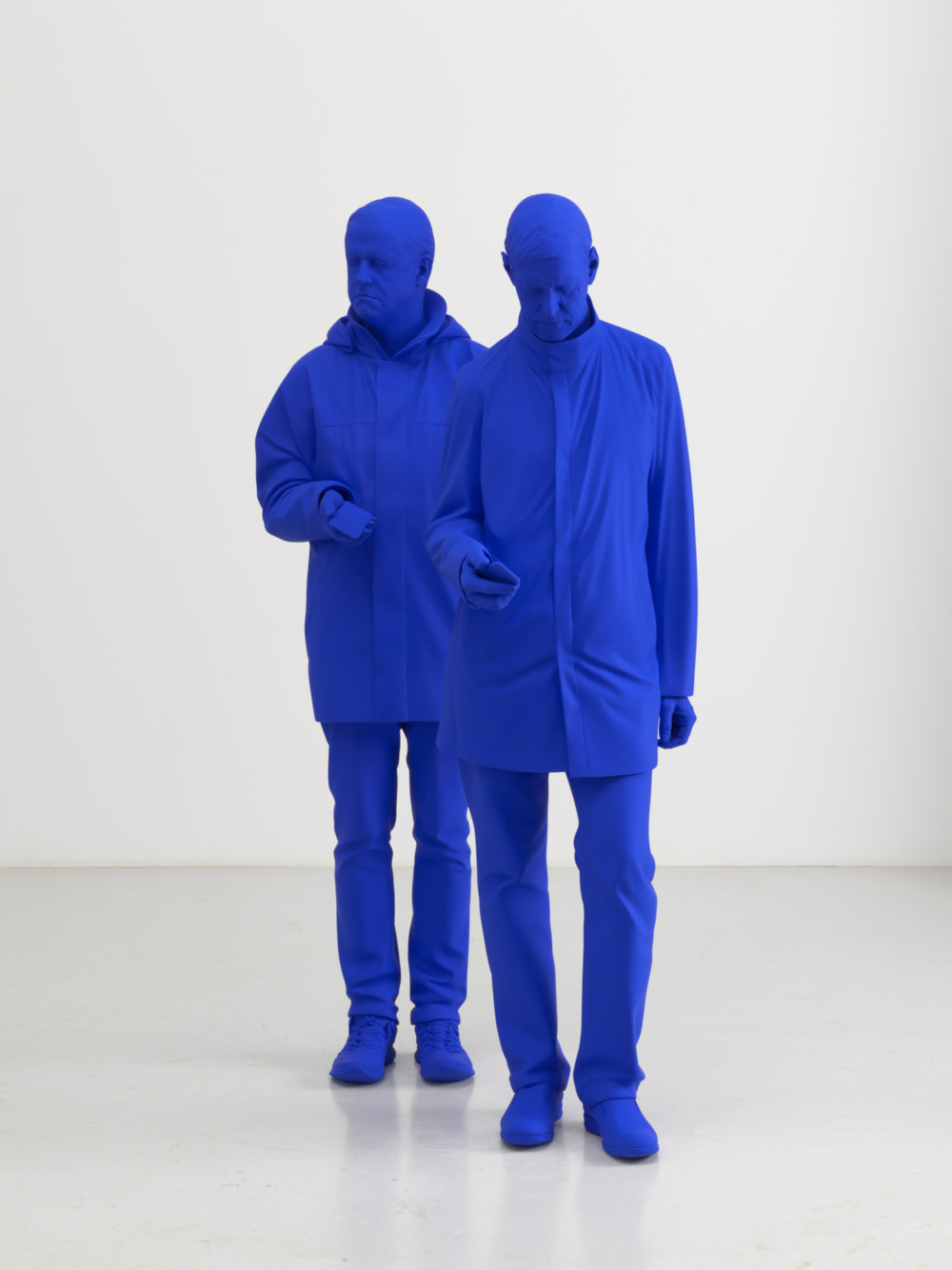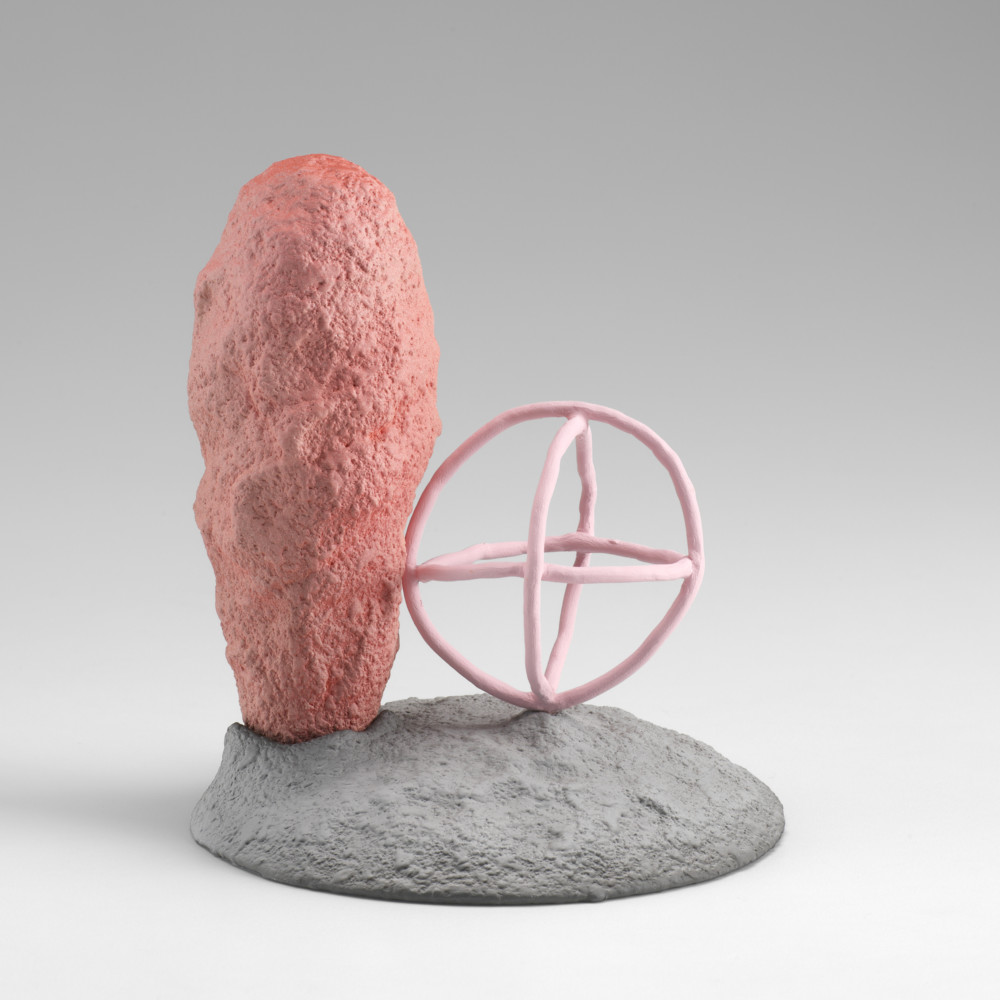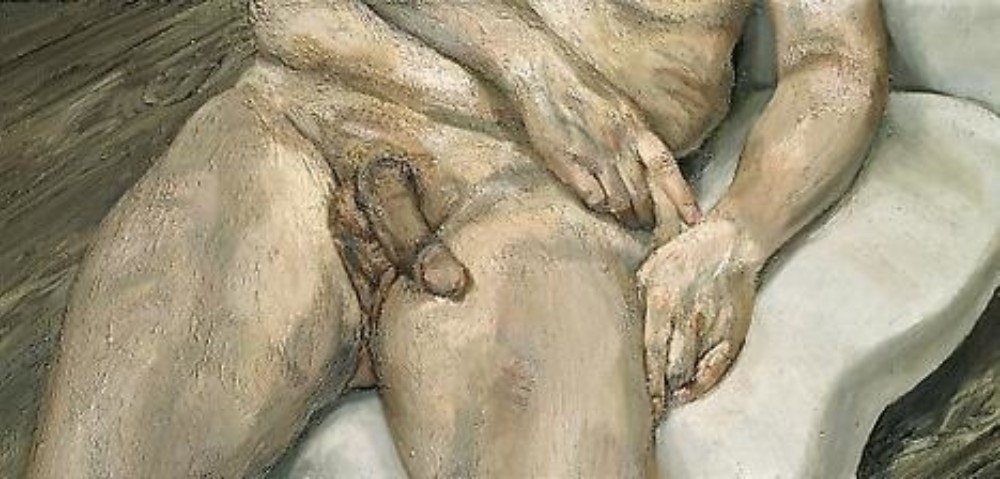Katharina Fritsch

Hahn / Cock 2013 Glass-fiber reinforced polyester resin fixed on a stainless-steel supporting structure 173¼ × 173¼ × 59 inches; 440 × 440 × 150 cm
Katharina Fritsch’s sculpture often begins with an archetypal image, which she subverts with shifts in scale and color. Madonnenfigur / Madonna (1987) is based on a small statuette of the Virgin Mary that Fritsch enlarged to her own height and painted a vibrant yellow. Other sculptures depict life-size figures as different characters and types, all male, including a chef, a giant, and an art dealer. But Fritsch is perhaps best known for her uncanny animal sculptures. Rattenkönig / Rat-King
(1993) is a circle of sixteen gigantic rats, each nearly ten feet tall, with their tails tied in a massive knot at the center. Art historian Jean-Pierre Criqui has said of Fritsch’s animal sculptures, “The way the artist uses them, but also the situations in which she places them, gives them ambiguous powers at the intersection of several tendencies: humanity’s ancestral fears and superstitions, as expressed, for example, in tales and legends; the intensities of totemic thought and of its images; and the uncanny and Freudian dream study.”
Typically each work is molded by hand, then cast in plaster, reworked, and then cast again in polyester. The polyester form is finished with a matte paint, which absorbs light, giving the sculpture’s surface a disorienting immaterial quality. “My sculptures can never be totally grasped, like a picture that has something unresolved about it,” Fritsch has explained. “They stay in your head like an enigma. That’s how life seems to me and that’s how I depict it.”
Katharina Fritsch (b. 1956) lives and works in Düsseldorf. She represented Germany at the 1995 Venice Biennale and has had one-person exhibitions at museums across Europe and the United States, including the Kunstmuseum Basel, the San Francisco Museum of Modern Art, the Art Institute of Chicago, Tate Modern in London, and K21 in Düsseldorf. In 2009 her work was the subject of a retrospective at Kunsthaus Zürich and the Deichtorhallen Hamburg. In 2013 she created Hahn / Cock, an enormous sculpture of a bright blue rooster, for London’s Trafalgar Square. Versions of the work are now on view at the National Gallery of Art in Washington, DC, and the Walker Art Center in Minneapolis.
Selected Works

Elefant / Elephant 1987
Polyester, wood, paint
Madonnenfigur / Madonna 1987
Epoxy resin, paint
Tischgesellschaft / Company at the Table 1988
Polyester, wood, cotton, paint
Rattenkönig / Rat King 1993
Polyester resin, paint
Händler / Dealer 2001
Polyester, paint
Frau mit Hund / Woman with Dog 2004
Polyester, iron, wood, paint, two parts
St. Katharina & 2. Foto (Efeu) / St. Katharina & Photo 2 (Ivy) 2006–07
Polyester, acrylic paint, and oil-based ink and acrylic on three plastic panels
Figurengruppe / Group of Figures 2006–08
An installation of nine sculptures in polyester, paint, epoxy resin, and lacquer
Muschel (Hellgrün) / Shell (Light Green) 2015
Bronze, paint
Exhibitions

KATHARINA FRITSCH
May 5–June 17, 2023
526 West 22nd Street
New York

KATHARINA FRITSCH
February 13–May 2, 2020
1062 North Orange Grove
Los Angeles

KATHARINA FRITSCH
November 4–December 22, 2017
523 West 24th Street
New York

KATHARINA FRITSCH
May 3–June 14, 2008
522 West 22nd Street
New York

KATHARINA FRITSCH
November 6–December 24, 2004
522 West 22nd Street
New York

KATHARINA FRITSCH
April 29–June 23, 2000
522 West 22nd Street
New York

KATHARINA FRITSCH
New Work
April 19–June 8, 1996
1018 Madison Avenue
New York
Group Exhibitions

ALEX DA CORTE, TRISHA DONNELLY, KATHARINA FRITSCH, KEN PRICE, TERRY WINTERS
September 11–October 9, 2021
1062 North Orange Grove
Los Angeles

THOMAS DEMAND, KATHARINA FRITSCH, ROBERT GOBER, BRICE MARDEN, KEN PRICE, MARTIN PURYEAR, CHARLES RAY, PAUL SIETSEMA, ANNE TRUITT, TERRY WINTERS
September 14–October 21, 2017
1062 North Orange Grove
7818 Santa Monica Boulevard
Los Angeles

PAVLOVA’S DAWG
and Other Works by Gallery Artists
April 30–June 25, 2016
1062 North Orange Grove
7818 Santa Monica Boulevard
Los Angeles

10 SCULPTURES
July 11–August 29, 2015
1062 North Orange Grove
7818 Santa Monica Boulevard
Los Angeles

SUMMER GROUP EXHIBITION
July 19–August 16, 2014
1062 North Orange Grove
7818 Santa Monica Boulevard
Los Angeles

PETER FISCHLI DAVID WEISS, KATHARINA FRITSCH, MARTIN HONERT, GARY HUME
July 10–August 14, 2014
523 West 24th Street
New York

SCULPTURE
Katharina Fritsch, Robert Gober, Jasper Johns, Ellsworth Kelly, Martin Puryear, Charles Ray
February 8–April 19, 2014
523 West 24th Street
New York

DARREN ALMOND, KATHARINA FRITSCH, MARTIN HONERT, GARY HUME, PAUL SIETSEMA, REBECCA WARREN, TERRY WINTERS
July 14–August 25, 2012
1062 North Orange Grove
Los Angeles

NEW WORK
Katharina Fritsch, Robert Gober, Nan Goldin, Andreas Gursky, Martin Honert, Charles Ray, Terry Winters
September 10–October 16, 2010
522 West 22nd Street
526 West 22nd Street
523 West 24th Street
New York

PAINTING: NOW AND FOREVER, PART II
July 3–August 15, 2008
522 West 22nd Street
New York

SMALL SCULPTURE
September 23–October 28, 2006
523 West 24th Street
New York

SCULPTURE
Darren Almond, Peter Fischli David Weiss, Katharina Fritsch, Robert Gober, Donald Judd, Ellsworth Kelly, Ugo Rondinone, Tony Smith
September 20–November 1, 2003
522 West 22nd Street
New York

TORN BETWEEN TWO LOVERS
An exhibition curated by Katharina Fritsch
July 9–August 15, 2003
522 West 22nd Street
New York

SOMETHING ANYTHING
An exhibition curated by Nayland Blake
July 2–August 16, 2002
522 West 22nd Street
New York

100 DRAWINGS AND PHOTOGRAPHS
Tenth Anniversary Exhibition
November 3–December 22, 2001
523 West 24th Street
New York

DRAWINGS AND PHOTOGRAPHS
Foundation for Contemporary Performing Arts Benefit Exhibition
December 8–December 23, 2000
522 West 22nd Street
New York

WILLEM DE KOONING, PETER FISCHLI DAVID WEISS, LUCIAN FREUD, KATHARINA FRITSCH, RONI HORN, ELLSWORTH KELLY, BRICE MARDEN
September 25–November 27, 1999
522 West 22nd Street
New York

MAVERICK
Jean-Marc Bustamante, Peter Fischli David Weiss, Katharina Fritsch, Roni Horn, Thomas Schütte, Andreas Slominski
February 7–April 11, 1998
522 West 22nd Street
New York

SUMMER GROUP EXHIBITION
Richmond Burton, Peter Cain, John Chamberlain, Katharina Fritsch, Andreas Gursky, Roni Horn, Gary Hume, Andy Warhol









